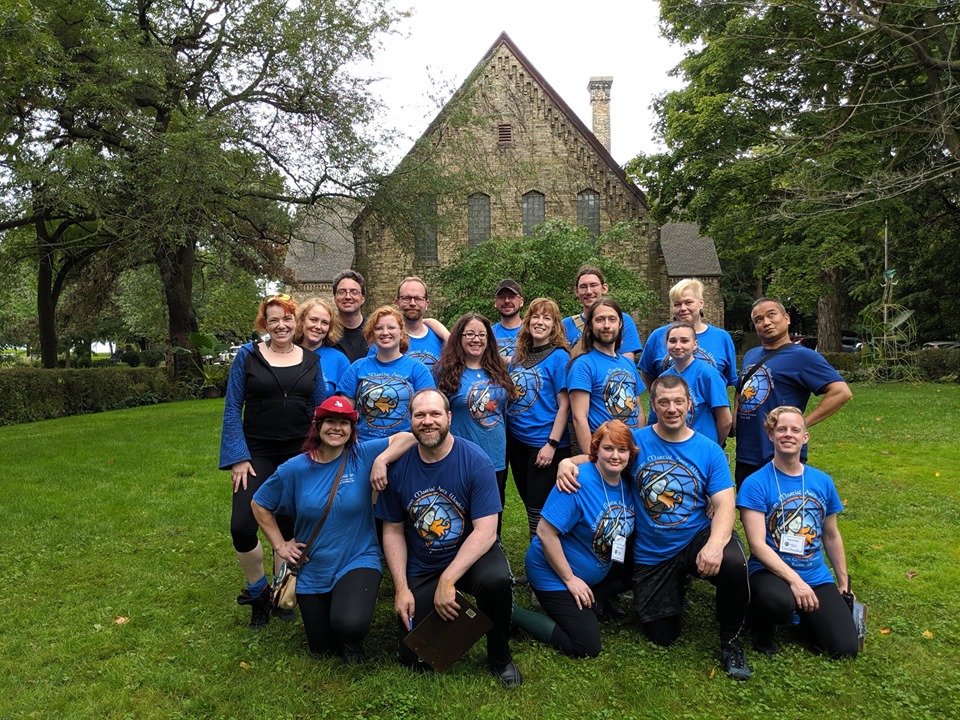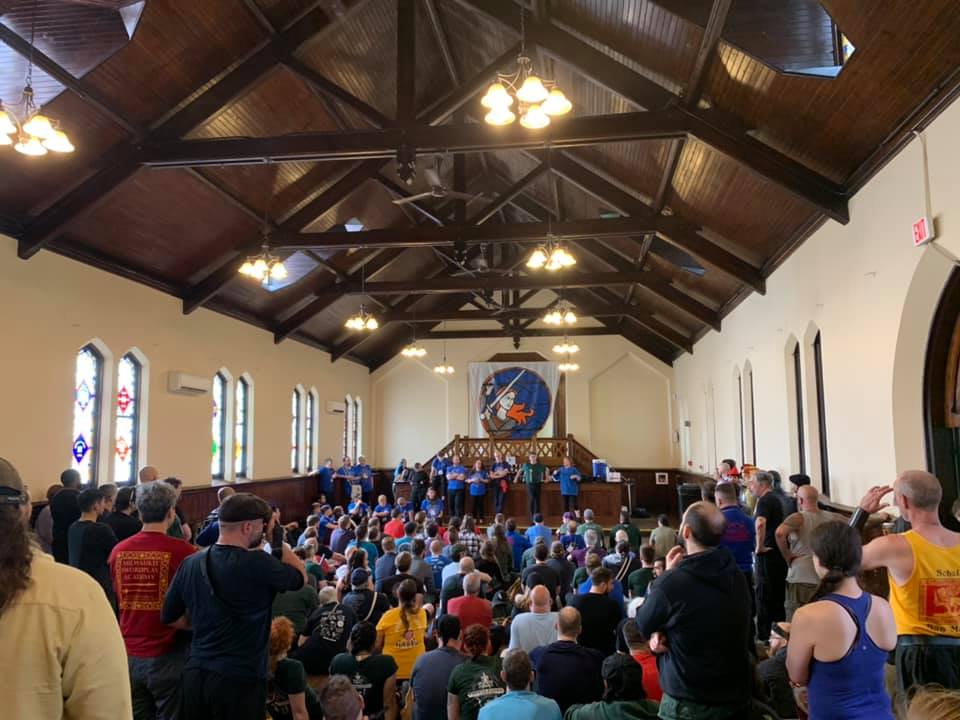
NB: Click on images for their full glory!
Back in 1999, back when the term “HEMA” was years from existing, Col. Dwight McLemore of The School of Two Swords, Pete Kautz of Alliance Marital Arts (and coiner of the term Western Martial Arts) and I decided that we would host a small gathering of ourselves, our students and a few other teachers of Euro-American fighting arts. Since Chicago was centrally located in the US, with two major airports, we decided I would host. We named the event, subtly, I think, the “Western Martial Arts Workshop” or W.M.A.W (we say the acronym by pronouncing each letter, not W-MAHW). We had no staff besides myself and my friend Aaron Popowtich, and 35 people (34 Americans and 1 Canadian, making it an ‘International’ event ) with one track of classes.That was 1999.
Twenty years later, WMAW is going strong: we had over 200 people from the US, UK, Canada, Australia, Germany, Italy and New Zealand. We also had our most ambitious and complicated schedule, hands down, with a fourth class track, a second armoured deed (aka “The Mini Deed”), a Destreza challenge event, and three hours of mass combat experiments.
HOPLITES, AND CONDOTTIERI AND DRONES — OH MY!: MASS COMBAT EXPERIMENTS
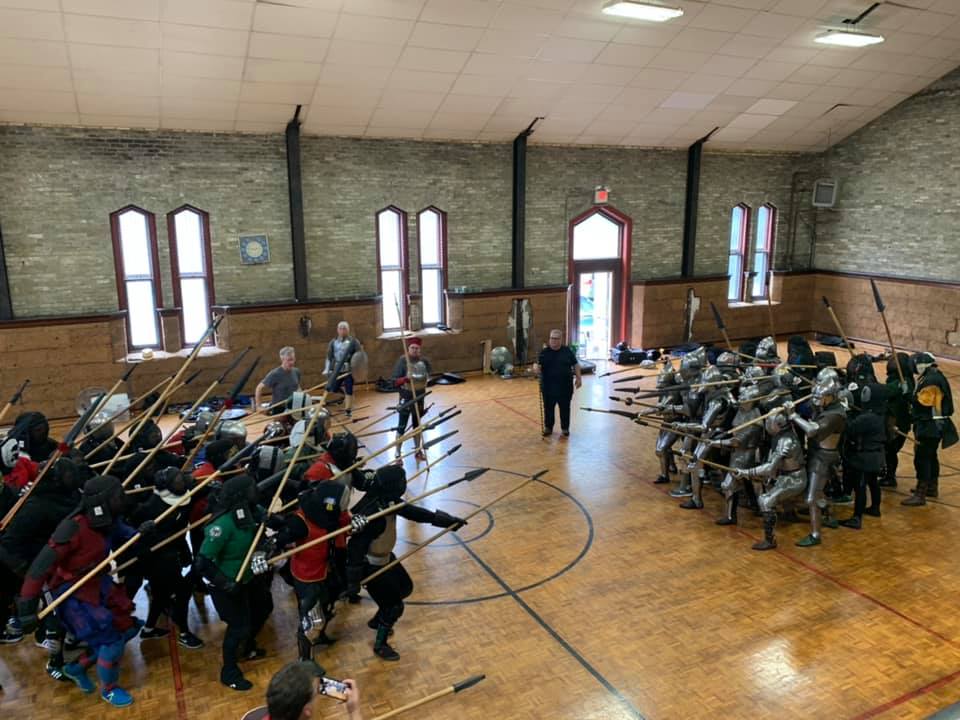
Firstly, I must thank my dear friend, fellow pilgrim (literally), and co-conspirator, Christian G. Cameron, for talking me into the Hoplite Experiment, and a similar, late medieval counterpart: the Italian Experiment. “We have neither the room nor the infrastructure to do this.” I insisted. “But when else are we going to get 40 or 50 trained HEMA people to slam into each other with shields?” As it turned out, we had just over 60 people slamming into each other, over and over, all in the name of science. Special kudos to Dr. Paul Bardunias, who made us scientifically legit, and looked like a kid in a candy store, as he strapped a force meter onto his chest and let himself be squished at the center of two engaging phalanxes. From Paul I also learned how little I know about either hoplite warfare or entomology, but that is another story.
(You can see a bunch of video of the experiments, shot by overhead drones, here.)
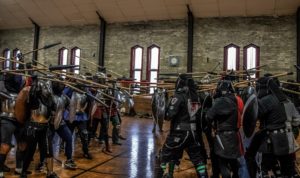
Now, if Christian was going to get his hoplites, there was no way he was getting a bunch of people who had never used a spear and shield before…so

before long we had an entire mini-track of classes, beginning with partisan used alone, then moving on to partisan and rotella, followed by classes taught by Christian on sword and rotella,
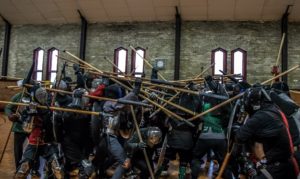
combined arms (throwing the spear and switching to swords, both in a Renaissance context and with the Greek xiphos short-sword — including convincing mechanical proof as to WHY the sword is held in the left hand), and finally, armoured spear fighting, co-taught with Chris Duffy. Christian, I am afraid that the secret is out and you can never get away with saying “I’m just a reenactor” again!
DEEDS OF ARMS: CLASSIC and MINI-DEED
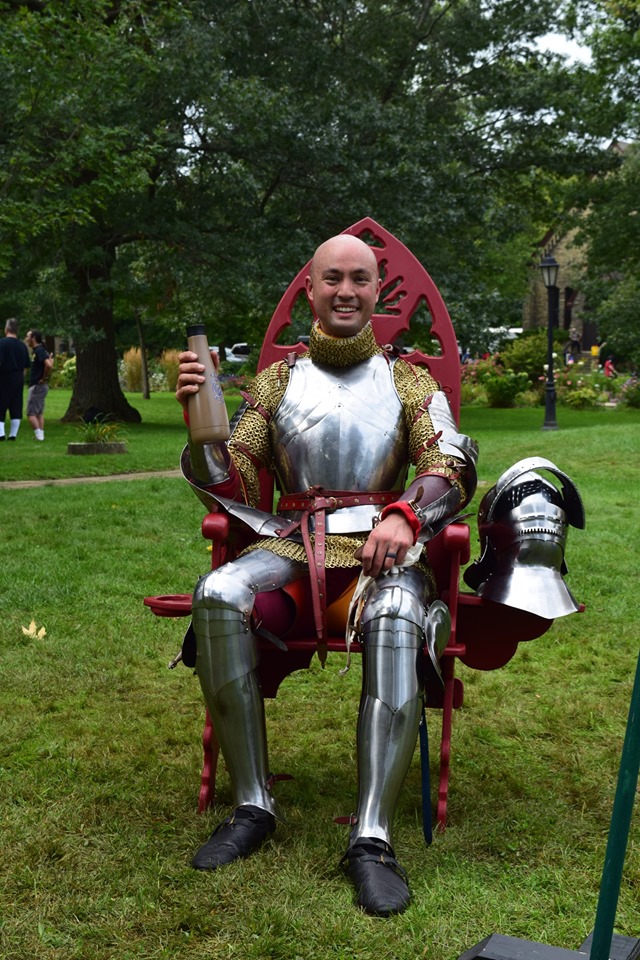
Secondly, I must also thank my friend and WMAW stalwart, Bill Grandy of the Virginia Academy of Fencing. Bill proposed that we have a shortened armoured track, but combine it with an elimination tournament named “the Mini Deed”. That convo went like this:
“Bill, that sounds cool, but we don’t have class space.”
“We do it on the green, in the list.”
“What if it rains?”
“It never rains at WMAW.”
“How do we staff this?”
“Guys, if we do this, I will run it all myself. I will spend my entire event on the list, in armour, coaching fencing, teaching, and will organize and run the Mini Deed. All you have to do is say yes.”
And he did! Literally! Bill, you are an armoured mensch of the first order (and your armoured bling this year was INSANE). I’d tell you all about who won the Mini Deed, but first rule of Mini Deed is you don’t talk about who won Mini Deed. Sorry.
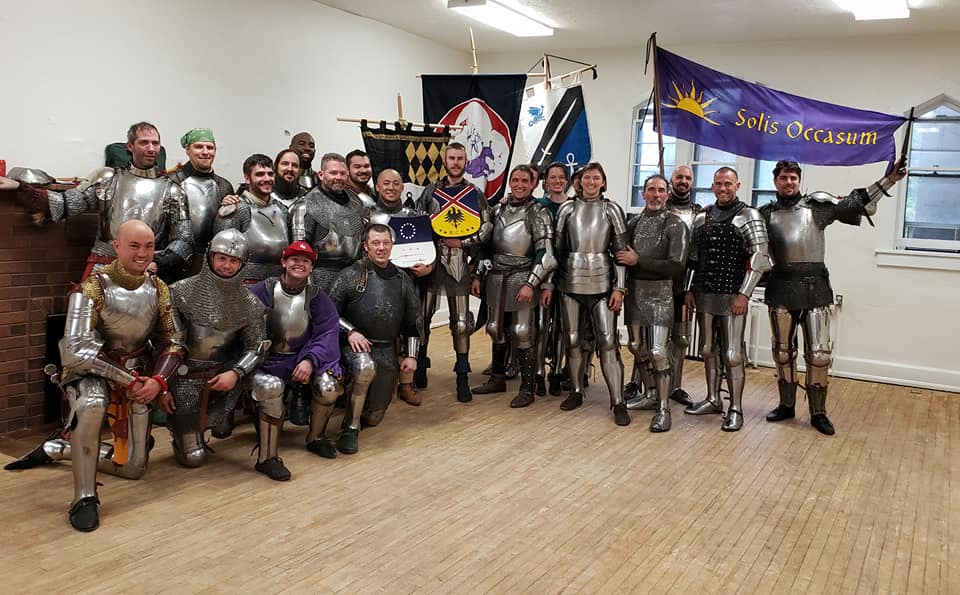
By the way, thanks to all of the MD combatants, who rolled with the punches as Mini Deed turned into Armoured FightClub, when we had to move into an indoor space the size of a good master bedroom BECAUSE IT RAINED!
Unfortunately for Bill, I had at least a third of the MD people ask if we will do it again next WMAW…
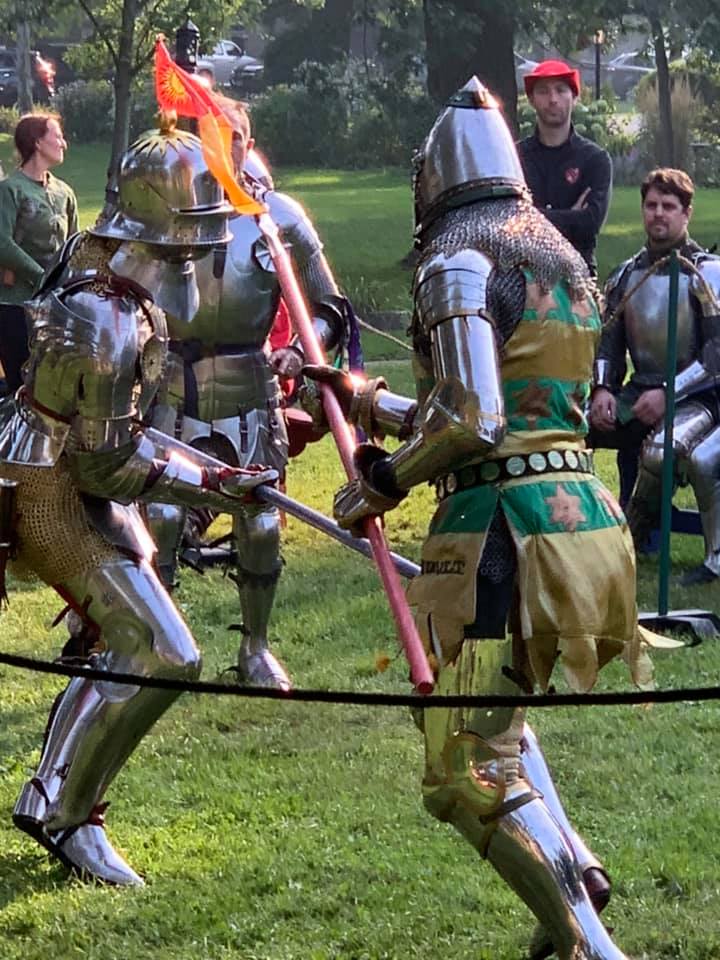
Of course, we also had our formal, armoured Deed of Arms, which saw over 20 combatants in full harness, including five ladies-at-arms, our largest contingent of female armoured fighters ever! The Deed was well-fought, with a lot of good will, even though Team Italy, with primarily c. 1390 harness was a bit behind in the arms race (and thus target opportunities) against the mid-to-late 15th harness Team Germany combined with their excellent fencing skills!
The entire Deed of Arms can be seen here:
Now, by dumb luck, this was also the 450th anniversary of Carranza’s Philosophy of Arms, so Puck Curtis and Eric Myers approached me wanting to hold…a special event. Called The Parson’s Challenge, this was a bit like a prize fight, where Diestros would hold the floor against all comers. By this time I was eating Tums like Skittles trying to figure out how to fit all of this in. I realized I had an easy out:
“Sure, you guys can do that, if you teach a class on Iberian three-chain flail.” This is the three-sectional-staff of HEMA — more dangerous to the wielder than anyone else. No one in their right mind would say yes to that….
…so, the Parson’s Challenge was awesome, and it turns out that the flail is one of the most fun, if terrifying, weapons I have ever trained with. Oh, and I forgot, Puck isn’t in his right mind. Fortunately, no one was killed in the flail class, though everyone hit themselves at least once.
INSTRUCTORS NEW AND OLD
From its inception, WMAW has been about showcasing state of the art research, established instructors and new faces (either to the community at large or to North America), and we try to rotate about 20 – 25% of the instructors each year. This year was no exception, and I’d like to call out some of the new faces this year, because I was really pleased with what they brought to the event.
Ian Brackley and I have known each other since the early SwordForum days, but did not meet until maybe four years ago. It still took Christian Cameron and I another few years to get him to come to WMAW. Ian had an unenviable job: reintroduce smallsword to an event where previously, the smallsword class had been so badly received that about a third walked out early and for years after it was talked about as “where fun goes to die.” And honestly, this is a very demanding, form-dependent weapon where an inch out of line might as well be ten.
But Ian pulled it off, in spades. I could not believe how many people listed his smallsword classes in their top two or three favorites for the weekend. These weren’t all Italian rapierists having an affair with a French mistress, either; some were longsword students and backsworders. Everyone said that, besides making it look easy, Ian made the class engaging, fun, and was so filled with knowledge about the era and its culture, that they felt like they were in an 18th c salle d’armes.
CSG Provost, John O’Meara and Ian Brakley engage in a friendly smallsword bout on the green.
The smallsword’s bete noir is the broadsword, and I knew early on that I wanted Jay Maas at the event to give us his take. Jay and I had never met, but I had seen his videos and had been impressed at his combination of prowess, technical precision, humility and clarity. For the record, Jay Maas in person is all of that but much more. Yeah, he’s tall, strong, fast and a good fencer, but he’s also a truly genuine, big-hearted soul who has a child-like delight in what HEMA and WMA can be. Jay’s barely over 30; I wish I had been as gifted at the same age. Jay has recently taken up Armizare and rapier, and I can only imagine that in a few years he’ll be just as brilliant at that.
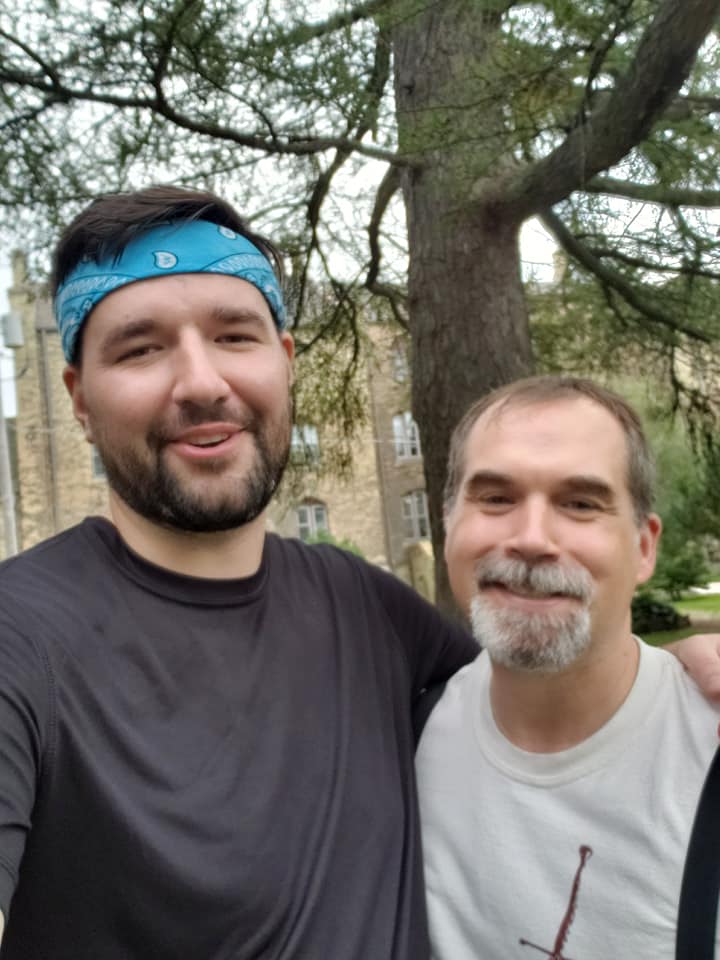
My good friend James Reilly was the driving force behind the Midwest Historical Fencing League, the man who badgered me until I agreed to hold the Midwinter Armizare tournament, and that always smiling, helpful guy at any event out this way. And everyone forgets that he is a serious martial artist and student of Meyer. I was determined to remind everyone otherwise, and I heard a lot of positive feedback from his langeort class, not that I expected otherwise.
I also would like to gush on two of my own. Davis Vader asked for a chance to teach partisan and rotella as part of the “mass combat” preparatory classes, and spent six months developing an entire curriculum that would easily fill a weekend workshop. (I was of zero technical help, because the most I have done with partisan and rotella is watch other people teach it.) He did a fantastic job of paring his extensive notes and drills down to a manageable 90 minutes, and I was extremely impressed by his command of both the material and the classroom.
I’ve talked about all of the new (or new to WMAW) teachers I invited, but my student Scott Scooter Jeffers had a particularly daunting task: with two weeks of prep teach a class on Marozzo’s two-handed sword, and make it interesting enough to people would not be too disappointed that Roberto Gotti and Jacopo Penso of Guardia di Croce were not there teaching. No small task, and Scott took it up happily (if a bit nervously). Fortunately, this whole year he has been working on developing a Marozzo curriculum, teaching at progressively larger venues…and of course, he has an amazing pair of Marozzo-style pants! Seriously though, we billed the class as taught by Rob and Scott, but I think it became clear that it was Scott running the show!
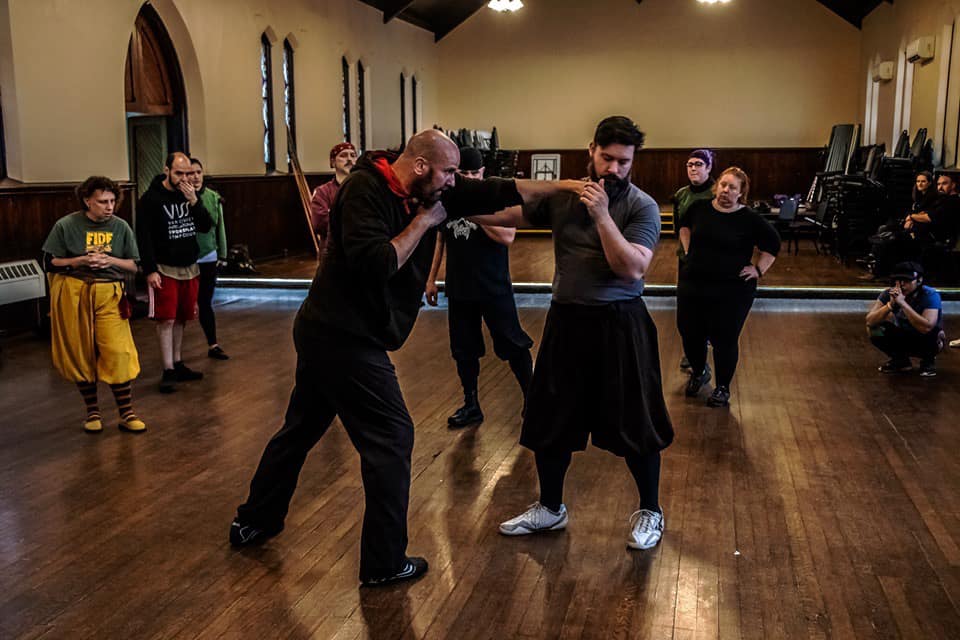
I met George Livermore at the first AIMA Rome meeting, and again in Malta. George is larger than life (in personality, not just height), swings a might rapier (or is that a spear?) and was admirably assisted by Derek Steel-Baron. Together they look like, and have the names of, a pair of Edwardian adventurers. They’re also a delight who spread the 1595 Club’s unique approach to Saviolo as a comprehensive martial system. George, stick around a little longer next time.
Of course, not everyone who is new to WMAW is new to our community. Dustin Reagan is well-known to North American HEMAtists, and I was happy to finally get him to WMAW. Likewise, Francesco Lodà is an internationally renowned swordsman, teacher and scholar, and one of the finest people you will meet anywhere. It was my privilege to host he and Silvia Tomassetti at WMAW and afterwards spend some time showing them Chicago, as they did with me in Rome.
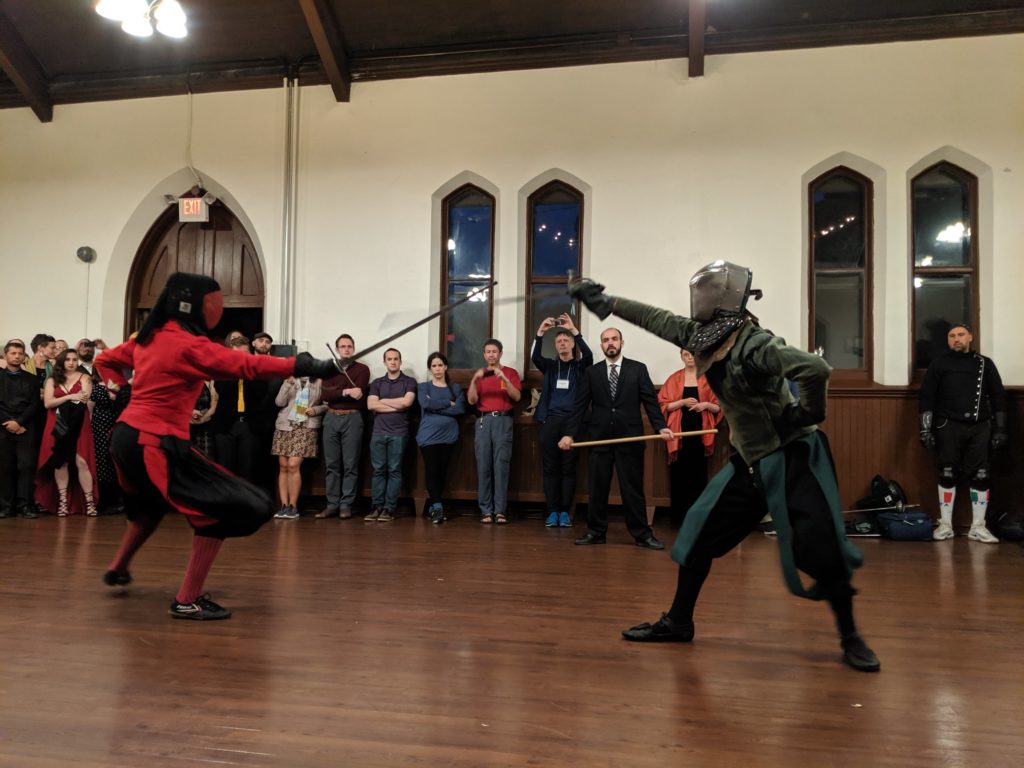
Finally, for new faces, I always keep a lecture or class in reserve for those last minute cancellations. This year, Adam Franti stepped up with a lecture on the martial culture of the Fechtschule. This was a lecture on 16th c ideas of masculinity, class, the changing notions of “nobility”…and yeah, fencing. Adam looks at Meyer and Fabris the way I do Armizare — windows onto a time and place at once familiar and alien to our own world. But as he demonstrated at the Saturday night fighting demos, he puts practice to page — his Meyer rapier/sidesword demo with Rob Rutherfoord was a clinic in technical excellence.
Of course, WMAW is also about the usual suspects, who are the usual suspects because they are so good at what they do:
Devon Boorman is my event workhorse, who fills in schedule gaps, can teach, lecture or teach on teaching, and always is there to get me out of a pinch. I *think* I might not have worked him quite as hard this year; instead he got food poisoning.
Michael Chidester is the arch-nerd of HEMA, and that is a complement! I attended both of his lectures, the one on the duel making a perfect complement to the one I gave two years ago. As always, Mike never disappoints, and has the best trait of a researcher: he has no problem saying, “two years ago, I stood here and said xyz. That was wrong and this is why.” That’s what cutting edge work means, folks. Of course, he doesn’t have it to say it that often.
Jess Finley was one of the folks who took a couple of WMAW’s off and I was really glad to have her back. Her positivity is infectious, and while, yes, she is an inspiration to female students, who remain a WMA minority, she is an inspiration for *anyone* who wants to knuckle down, grind out the work and get it done. The CSG’s motto is Ferrum non Verbun and more than almost anyone else I know. Jess has an incredible work ethic, a great classroom persona and gets the best out of people. I am so deeply annoyed I missed her lecture, I just can’t even…
Sean W. Hayes is a classical fencing master who turned medieval barbarian and is happily ensconced in the 14th century. We teach the same material, often with identical interpretations, but I always learn something about *teaching* when I take or observe one of his classes.
Stephen Hand goes back to WMAW 2001 — held in Manhattan a month after 9/11 and was a regular fixture until life intervened and kept him away for…14 years. Don’t do that again, Steve. (Actually, he won’t, because he, Adam Franti and I have an idea for a “School of the Renaissance Soldier” track at the *next* WMAW…)
John O’Meara and Rob Rutherfoord always bring their a game to their classes, and I always feel a bit of unearned pride sharing them with the community.
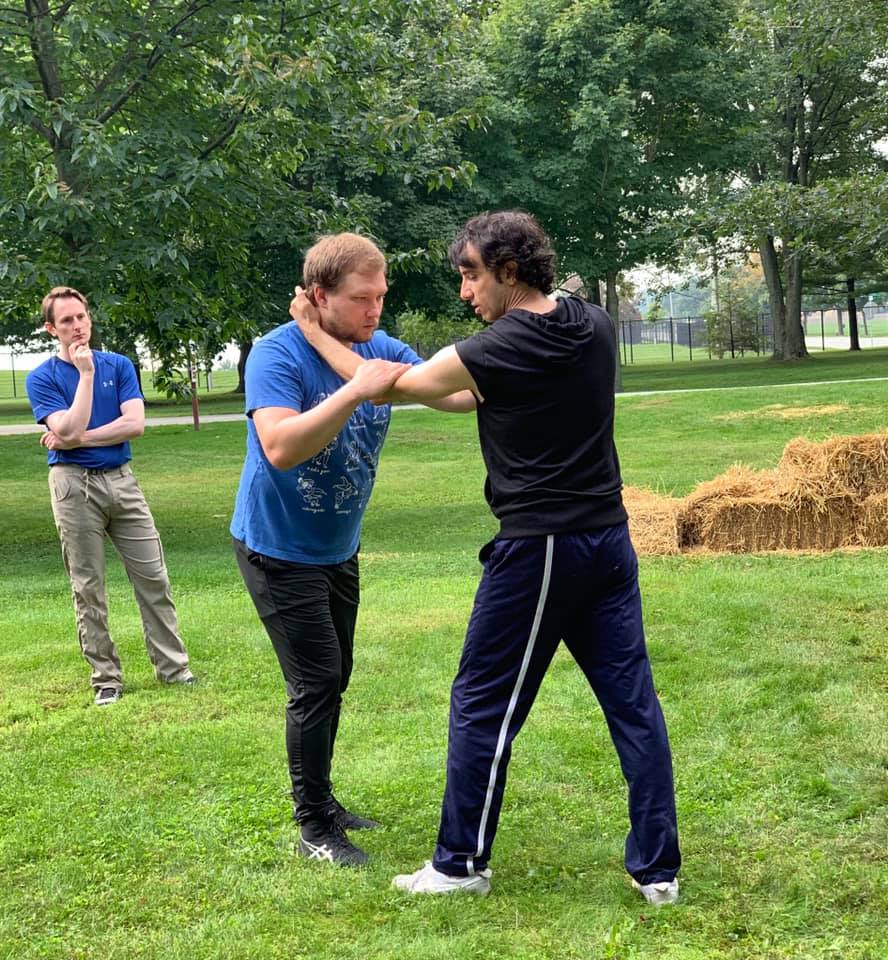
Marco Quarta is another person who always bails me out when I need to fill a suddenly vacant class description. Marco is literally a “warrior-philosopher” in the Renaissance model; which is what makes it so much fun to watch folks come out of his wrestling class saying “but, he always seemed so…nice.” Every time we are together, my friend, my life is richer.
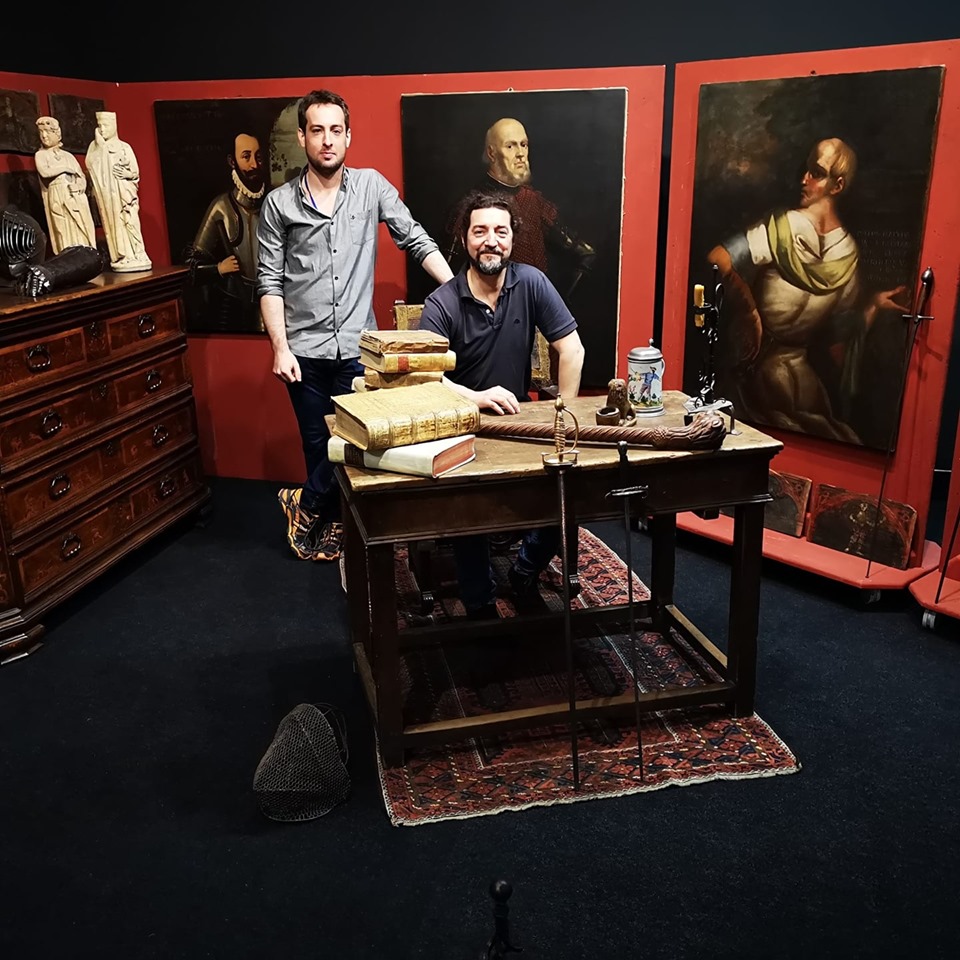
There is a lot of discussion about “what is a modern WMA master”? Clearly, such people have never met Ton Puey. Ton can literally wield any weapon you put in his hand, can do so in a way consistent with his art, can look effortless doing it, and then can teach you to do the same — in his third language. He is an encyclopedia of Destreza, the martial culture of Golden Age Spain, and as generous, patient and friendly an instructor as you will ever meet. I want to be Ton when I grow up, which is unfortunate, since we are the same age. After a year off, Roland Warzecha returned — replacing his buckler with a full-sized viking shield. That was a class that I suspect killed a lot of assumptions, offered a lot of new insights and it was great to see and Steve Hand — whose research in the early 2000s into big shields launched Roland’s own — finally meet.
Finally, Da’Mon Stith returned this year to remind us that “Western” includes Africa and its diaspora as surely as it does Europe. Da’mon is one part griot and one part swordsman, a shy man until he steps to the front of the class and makes you work until you want to die — and that is the workshop. We have a saying that ‘last class period of WMAW is where good classes go to die’, because often people are so tired they decide to throw the towel in, Da’mon’s spear and shield class had 40 people registered and 34 on the floor — a first! And if you saw the impromptu sparring between he and Roland Warzecha that was part of it, you know why I am sorry I missed it. ![]()
I may have missed Da’Mon and Roland’s spear dance, but you needn’t! THIS is the best of what martial arts offer us!
STATE OF THE ART — SATURDAY NIGHT DEMO BOUTS
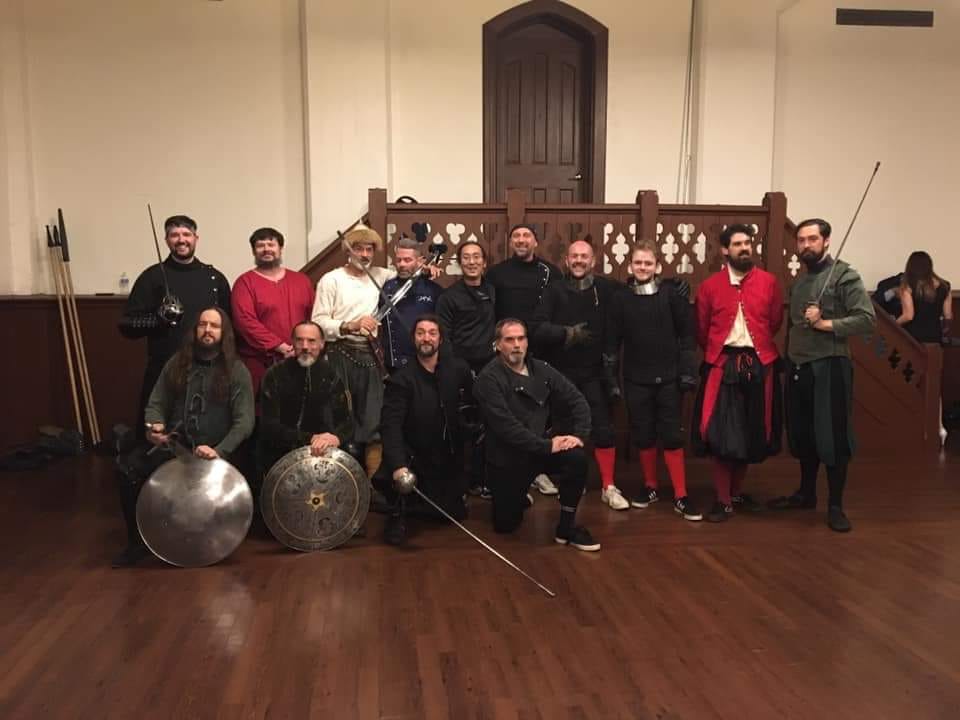
A highlight of WMAW is the Saturday night banquet and its demo bouts, showcasing some of the best and brightest in our community, as they try to present their art in its purest form. Over the years there have been some fantastic and memorable demonstrations, from a full Edwardian “Exhibition of Arms” including everything from single-stick to “suffragette jujutsu”; a three-way saber duel, a messer bout with sharp blades … dinosaurs (you had to be there)…a judicial duel…and more longsword and rapier bouts than I care to mention!
This year we really upped our diversity, with a walk through history, beginning with the Viking Age and ending in the era of the Jacobite uprisings. I will add this: not one featured the longsword, and no one missed it! WMA are more than HEMA, and HEMA is more than longsword — as a community we are at last seeing the breadth and depth of what we have to offer the martial arts world.
But you know, a picture is worth a thousand words, and a video must be at least ten times that, so here are all of those bouts, for your viewing enjoyment!
Bouts include: A Montante Flourish; Viking Sword and Shield; Partisan, Sword & Rotella; the short sword of George Silver; Scottish Broadsword; 16th century German Rapier ala Meyer; Late Italian Rapier; Destreza and Destreza vs. Italian Rapier.
FINAL THOUGHTS
This year, I taught classes, TOOK classes, heard three lecturers (spoiler: Carranza is THE chivalric righteous dude of HEMA) and got to see friends I don’t see enough. But that was largely because of the amazing people that actually make WMAW go: Nicole Allen or Chairperson, John O’Meara our Registrar (who is actually kept sane, and friendli-ish at the front desk by my beloved Tasha Dandelion Kelly), Christina Bailey our Hospitality Chair, Davis Vader, the instructor ride coordinator, and Jacques Marcotte our volunteer coordinator, who always puts together, the amazing crew of volunteers that Jacques assembles. I do all of the fun stuff, get all the profs, and they make the thing go.
OK, that’s enough from me. I usually gush less, but, standing here at the 20th anniversary looking back, I can’t even say this year’s event was dream back in 1999. I don’t know if there will be a 40th WMAW, nor do I have any idea who will be in my shoes, designing the program or writing the official review, but whoever they are, I think we are leaving them fertile soil to till.
My thanks to you all. See some of you at Armizare Academy 2020 and I hope many, many more at WMAW 2021!
